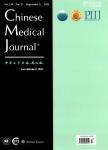Craniotomy with endoscopic assistance in the treatment of nasopharygeal fibroangioma
Craniotomy with endoscopic assistance in the treatment of nasopharygeal fibroangioma作者机构:Department of Neurosurgery Tongren Hospital Capital Medical University Beijing 100730 China Department of ENT Tongren Hospital Capital Medical University Beijing 100730 China Department of Neurosurgery Fuxing Hospital Capital Medical University Beijing 100038 China
出 版 物:《Chinese Medical Journal》 (中华医学杂志(英文版))
年 卷 期:2010年第123卷第10期
页 面:1289-1294页
核心收录:
学科分类:10[医学]
主 题:craniotomy endoscope nasopharygeal fibroangioma skull base
摘 要:Background Nasopharygeal fibroangioma (NPF) can be approached through lateral rhinotomy, the middle skull fossa approach and the transcranial-facial combined approach. It is complicated and thus results in more insults, and when adopted, the total resection rate of tumor is still low. The nasal endoscope is minimally invasive, the dead angles of a craniotomy, such as sphenoid sinus, maxillary sinus, and nasopharynx are easily approached by an endoscope. Lateral rhinotomy have to make facial incision and affects maxillary bone development. We combined the craniotomy and endoscopic approach intending to take advantages of the two approaches. Methods Twelve NPF patients who underwent craniotomy with endoscopic assistance from March 2002 to July 2008 at the Beijing Tongren Hospital were selected. All patients were male. Their ages ranged from 11 to 33 years. The main symptoms were visual deterioration, exophthalmos, nasal obstruction, epistaxis and pharynx nasalis neoplasm. The diagnosis was based on CT, MRI and digital subtraction angiography (DSA). All patients had intracranial encroachment and all underwent DSA and embolism treatment were taken before surgery. Seven patients had a pterional craniotomy, five had a frontal-temporal-orbital-zygomatic craniotomy. Most of the tumor was resected piecemeal, then removed through the sphenoidal sinus. Finally, using an endoscope in the nasal cavity, tumor in nasal cavity was resected and removed through the sphenoidal sinus, observing the dead angle of the craniotomy and confirming that sinus drainage was unobstructed. Results The tumor was removed completely in 11 patients and partially resected in one patient because of hemorrhage One patient had an infection after the operation and one patient had cerebrospinal rhinorrhea 3 years after surgery that was remediated by endoscopic repair. Conclusion Craniotomy with endoscopic assistance in the treatment of NPF was minimally invasive, safe and efficient, and avoided facial inci



